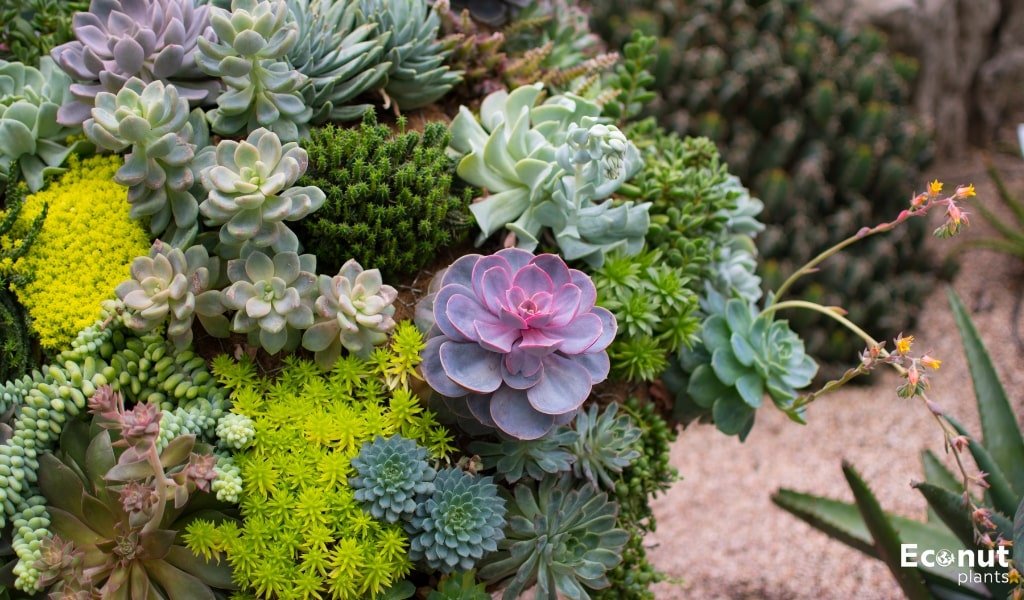Succulents, a large and diverse genus of plants, have seen tremendous growth in popularity recently. They are exceptionally well-suited to various environments, including arid and semi-arid ones, due to their remarkable capacity to hold water in their leaves, stems, or roots.
Adding a touch of natural beauty to homes, gardens, and even office spaces, these resilient plants have won over the hearts of both interior decorators and plant lovers.
However, have you ever considered the lifespan of these green friends? Together, we will learn more about succulents and their secrets to longevity.
Introduction to Succulents
What are succulents?
Plants known as succulents can survive in dry environments similar to deserts because of their capacity to retain water in their leaves and stems. Any plant fan will find them to be an appealing addition to any collection due to their vast array of shapes, sizes, and colours.
Popular types of succulents
Succulents occur in a variety of species, sizes, and forms, ranging from the traditional Aloe vera to the quirky-looking Echeveria. I’ll start by mentioning a few below:
- Aloe
- Snake Plant
- Jade Plant
- Sedum
- Sempervivum (Hens and Chicks)
- Kalanchoe
Lifespan of Succulents
Factors affecting the life span
Let’s discuss how long these stunning people can truly last. The following variables affect how long they live:
- Genetics: Some succulents are born with a longer lifespan than others.
- Species: The duration of each succulent’s shelf life varies.
- Growing conditions: If you take good care of them, they will provide you with many more years of wonderful green things.
Average lifespan
Succulents typically last three to five years, though with proper care, they can live much longer. When the right conditions are satisfied, they survive longer. These conditions include sunlight, soil that drains properly, irrigation, and occasional fertilizer.
Succulents provide for years of beauty and satisfaction by preserving equilibrium and shielding from extremes. These hardy plants outlive their typical lives when given proper care and attention, making them valuable additions to any collection.
Great Conditions for Lifespan
Adequate sunlight exposure
Similar to humans, succulents require a lot of sunlight to produce vitamin D. They will live longer if you put them in an area where they can receive adequate sunlight without burning.
Proper watering techniques
Overwatering succulents is not good for them. Water them sparingly, and don’t water them again until the earth is fully dry. Ensure that their roots are not overly moist by placing them in soil that allows water to pass through with ease.
Suitable soil and drainage
Succulents want a soil mixture that is light, and airy and allows for efficient water drainage. You may create the ideal growing conditions by adding gravel, sand, or perlite to the soil.
Signs of distress or aging
Identify common problems
Looking down at their plant is a sight that nobody enjoys. Notice the following warning signs:
- Sad, droopy leaves
- Unwanted visitors like bugs or diseases
- No new growth in sight
- Mushy stems
Tips for troubleshooting problems
Don’t panic if you notice any of these problems; sometimes your succulent only needs a little more care and love. Change the way you water them, give them a larger container so their roots can spread, or use pest control to stop them from spreading.
Extending Succulent Lifespan
Pruning and grooming
Bright, indirect sunlight and well-draining soil are ideal conditions for succulent growth. In between treatments, let the soil completely dry up and use minimal water. Report them when they outgrow their containers, making sure to trim off any dead areas to encourage healthy growth.
During the growth season, keep an eye out for pests and apply a little fertilizer. In the winter, cut back on irrigation and sunlight. These tips will ensure vibrant, long-lasting succulents.
Preventing diseases and pests
By keeping your succulents clean and giving them the attention they require, you may preserve their health. To fend off diseases and pests, plants require routine cleaning and maintenance.
Repotting practices
Succulents may begin to feel a little crowded in their pots as they get larger. If you give them bigger pots every few years, they’ll live longer.
Extending Lifespan Indoors
Choosing the right containers
Choose pots with drainage holes if you’re growing succulents inside. In this manner, any extra water can quickly drain away rather than remain and create issues.
Indoor care tips
Bringing indoor succulents? Not a problem! Simply make sure they get adequate light, give them water as needed (but not too much), and maintain airflow around them. They’ll have a new appearance.
Conclusion
We’ve now covered the typical lifespan of succulents as well as some strategies for keeping them alive longer. With a little love and care, these green jewels could grace your house and bring you happiness for many years to come.
FAQ
Is there a forever lifespan for succulents?
Succulents have a lengthy lifespan, but they are not eternal. If provided with appropriate care, they have the potential to live for several years.
Do succulents that are flowering eventually die?
Not always! With proper care, many succulents can continue to thrive even after they bloom, but some may pass away before then.
How long can succulents live indoors?
Succulents may survive for several years indoors under the correct circumstances, so you’ll have plenty of time to enjoy their company.

